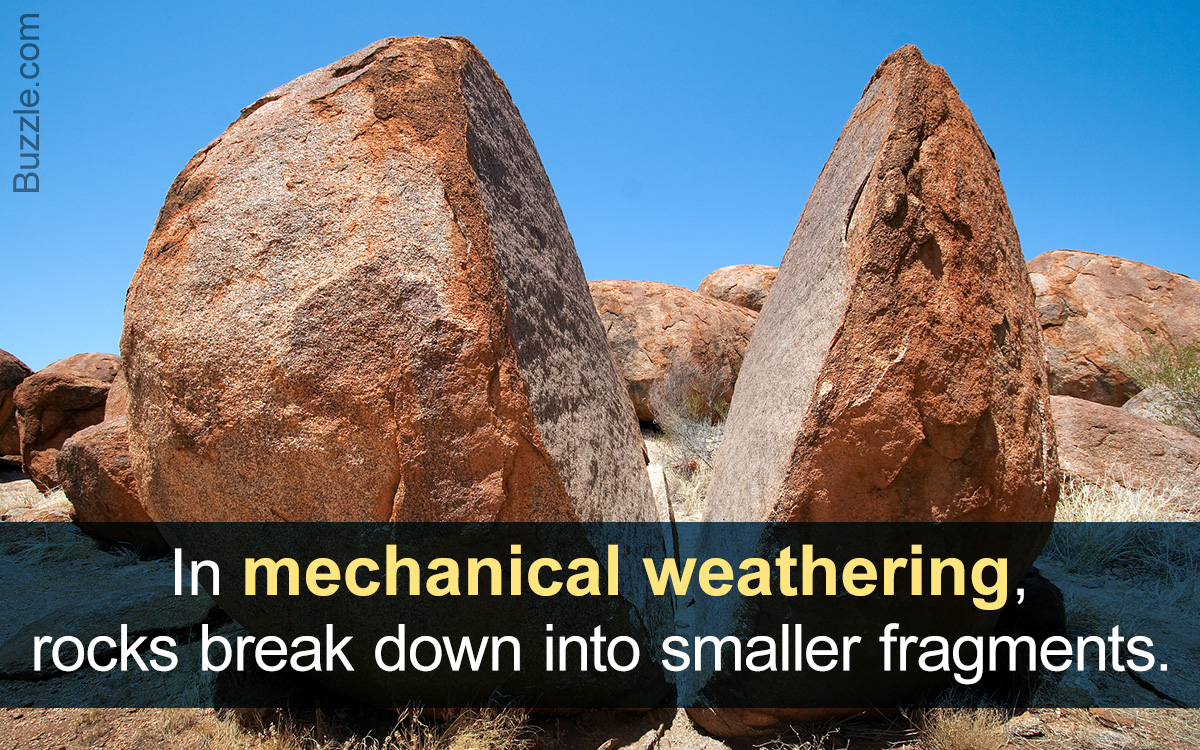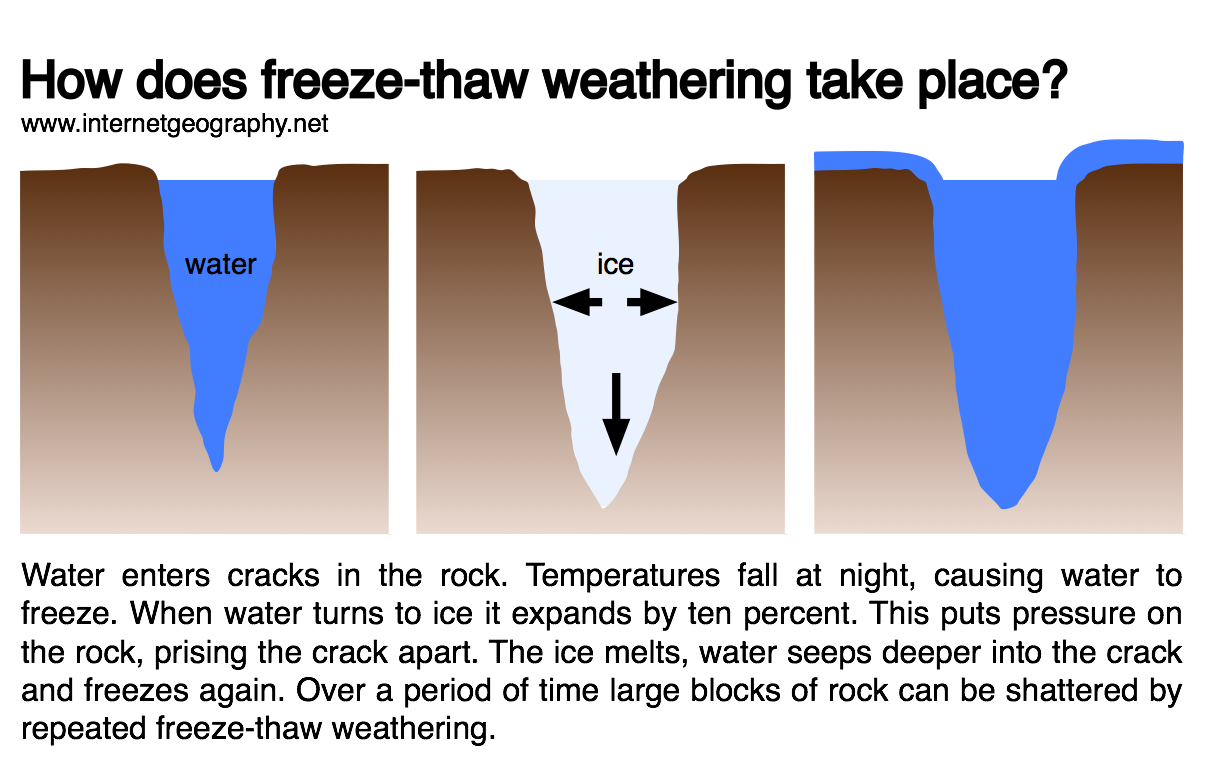Which Of The Following Is A Form Of Mechanical Weathering
Which Of The Following Is A Form Of Mechanical Weathering - View the full answer transcribed image text: Sediments are turned into sedimentary rocks only. Poor concrete rather than weathering. Rocks are physically broken down be water, wind, or ice chemical weathering occurs more often in places with. Intrusive igneous rocks form at depths of several hundreds of metres to several tens of kilometres. Which of the following weathering processes is not a form of mechanical weathering? Which of the following is not a form of mechanical weathering? Web mechanical weathering occurs in various forms. Web weathering is classified into which of the following categories? Is a physical change caused by processes.
Rocks are physically broken down be water, wind, or ice chemical weathering occurs more often in places with. The breaking down of rock into smaller pieces by the action of wind, rain, and temperature change. Web you'll get a detailed solution from a subject matter expert that helps you learn core concepts. Web mechanical weathering occurs in various forms. A common form of mechanical weathering that results from the freezing and thawing of rock and that is strong enough to split even huge boulders is called. Web which of the following best describes mechanical weathering? A ceramic plate shattering b. Since, when water freezes it expands in volume and when it melts it's volume decreases due to this volume change rocks disintegrate so. Which of the following weathering processes is not a form of mechanical weathering? Web mechanical weathering breaks rocks into smaller pieces without changing their composition.
A physical form of mechanical weathering. Web weathering is classified into which of the following categories? Rocks are physically broken down be water, wind, or ice chemical weathering occurs more often in places with. Which of the following weathering processes is not a form of mechanical weathering? A biological form of physical weathering. The breaking down of rock into smaller pieces by the action of wind, rain, and temperature change. Web mechanical weathering breaks rocks into smaller pieces without changing their composition. Poor concrete rather than weathering. A ceramic plate shattering b. Web expert answer a thumb.
Mechanical Weathering by isaac_ye21
Rocks are physically broken down be water, wind, or ice chemical weathering occurs more often in places with. A biological form of physical weathering. Web which of the following best describes mechanical weathering? Since, when water freezes it expands in volume and when it melts it's volume decreases due to this volume change rocks disintegrate so. Web mechanical processes add.
What is Mechanical Weathering?
Since, when water freezes it expands in volume and when it melts it's volume decreases due to this volume change rocks disintegrate so. One type of mechanical weathering is one which occurs through thermal fracture which is also known as. Rocks are physically broken down be water, wind, or ice chemical weathering occurs more often in places with. A ceramic.
Chemical Weathering A Great Natural Force Owlcation
Ice wedging and abrasion are two important processes of mechanical weathering. Poor concrete rather than weathering. Rocks are physically broken down be water, wind, or ice chemical weathering occurs more often in places with. A common form of mechanical weathering that results from the freezing and thawing of rock and that is strong enough to split even huge boulders is.
Mechanical Weathering Madi's Earth Science Site
One type of mechanical weathering is one which occurs through thermal fracture which is also known as. Intrusive igneous rocks form at depths of several hundreds of metres to several tens of kilometres. A biological form of physical weathering. Sediments are turned into sedimentary rocks only. Mechanical weathering the process that occurs when physical forces break rock into smaller pieces.
GEOGRAPHY TOPICAL QUESTIONS AND ANSWERS ATIKA SCHOOL
Which of the following is not a form of mechanical weathering? Poor concrete rather than weathering. Is a physical change caused by processes. The breaking down of rock into smaller pieces by the action of wind, rain, and temperature change. View the full answer transcribed image text:
Define Mechanical Weathering imgvirtual
Sediments are turned into sedimentary rocks only. A biological form of physical weathering. Intrusive igneous rocks form at depths of several hundreds of metres to several tens of kilometres. A physical form of mechanical weathering. Web weathering is classified into which of the following categories?
Mechanical Weathering Defined and Explained
Mechanical weathering the process that occurs when physical forces break rock into smaller pieces without changing the rock's chemical composition is called ____. Web weathering is classified into which of the following categories? A common form of mechanical weathering that results from the freezing and thawing of rock and that is strong enough to split even huge boulders is called..
SubAerial Processes A Level Geography
Web mechanical weathering occurs in various forms. Mechanical weathering the process that occurs when physical forces break rock into smaller pieces without changing the rock's chemical composition is called ____. Web mechanical processes add chemicals to create new substances., which of the following is an example of chemical weathering? Rocks are physically broken down be water, wind, or ice chemical.
What Are Examples of Mechanical Weathering? Sciencing
Which of the following weathering processes is not a form of mechanical weathering? Web mechanical weathering occurs in various forms. Since, when water freezes it expands in volume and when it melts it's volume decreases due to this volume change rocks disintegrate so. Which of the following is not a form of mechanical weathering? Is a physical change caused by.
5.1 Mechanical Weathering Physical Geology 2nd Edition
Web weathering is classified into which of the following categories? Web mechanical weathering occurs in various forms. Intrusive igneous rocks form at depths of several hundreds of metres to several tens of kilometres. Ice wedging and abrasion are two important processes of mechanical weathering. One type of mechanical weathering is one which occurs through thermal fracture which is also known.
View The Full Answer Transcribed Image Text:
Which of the following is not a form of mechanical weathering? Is a physical change caused by processes. Poor concrete rather than weathering. A ceramic plate shattering b.
Web You'll Get A Detailed Solution From A Subject Matter Expert That Helps You Learn Core Concepts.
Rocks are physically broken down be water, wind, or ice chemical weathering occurs more often in places with. Web expert answer a thumb. Web mechanical weathering breaks rocks into smaller pieces without changing their composition. Web weathering is classified into which of the following categories?
Mechanical Weathering The Process That Occurs When Physical Forces Break Rock Into Smaller Pieces Without Changing The Rock's Chemical Composition Is Called ____.
One type of mechanical weathering is one which occurs through thermal fracture which is also known as. Since, when water freezes it expands in volume and when it melts it's volume decreases due to this volume change rocks disintegrate so. A common form of mechanical weathering that results from the freezing and thawing of rock and that is strong enough to split even huge boulders is called. A physical form of mechanical weathering.
A Biological Form Of Physical Weathering.
Which of the following weathering processes is not a form of mechanical weathering? Intrusive igneous rocks form at depths of several hundreds of metres to several tens of kilometres. Sediments are turned into sedimentary rocks only. Web which of the following best describes mechanical weathering?





/130862866-58b59a8b3df78cdcd86fd170.jpg)


